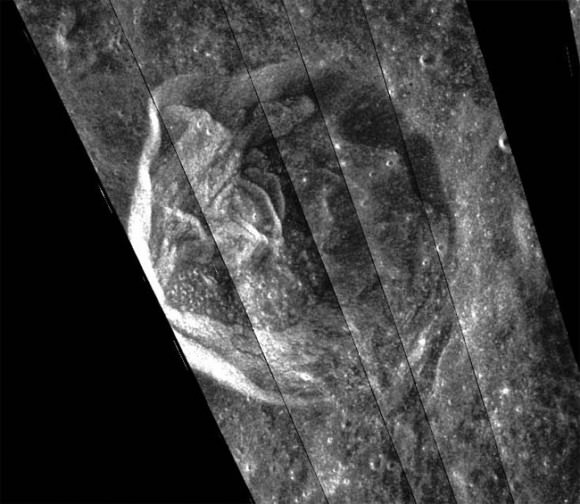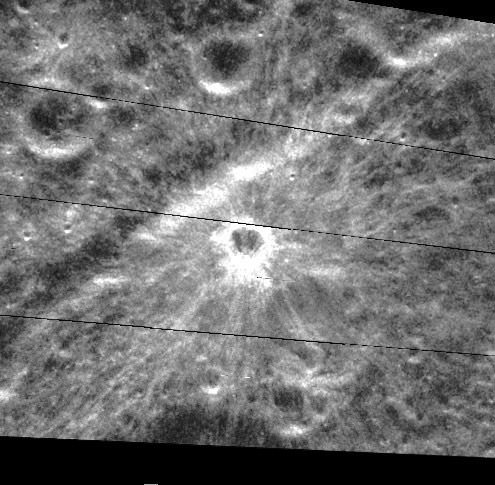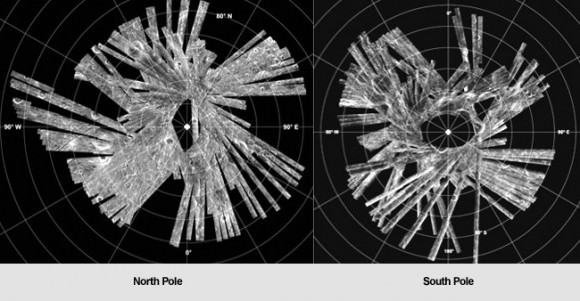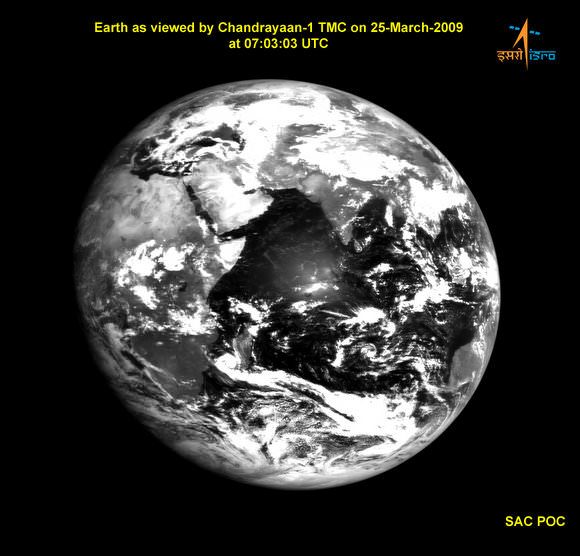[/caption]
ISRO and NASA have recently released some of the latest images taken by the Chandrayaan-1 spacecraft orbiting the Moon. Above, Chandrayaan 1 looks back at Earth, and fittingly, India is at the center of the image. And here’s a link to another similar image, taken about an hour earlier. Below, are images taken by the Mini-SAR, the imaging radar instrument that NASA has tagging along on the Chandrayaan-1 orbiter. “The new radar images are not only visually arresting, but they will be extremely useful in unraveling the complex geological history of the Moon as a whole,” said Dr. Paul Spudis, principal investigator for Mini-SAR. “We are hard at work finishing the calibration of our instrument, which is required in order to make definite statements about the nature of the radar backscatter signature, the tell-tale sign of the presence or absence of water ice.”

As you can see, the Mini-SAR gathers data in strips as it orbits the Moon, which are later assembled to create larger images. This composite shows Rozhdestvensky K, a moderately sized (42-kilometer [26-mile] diameter) impact crater on the southern rim of the larger crater Rozhdestvensky, near the moon’s north pole. These Mini-SAR images show massive slumping, as result of wall collapse caused by gravity. NASA says these images demonstrate that Mini-SAR images will be of great value in deciphering the geological evolution of the moon.

Here’s a very young, fresh impact crater (3 kilometers [nearly 2 miles] in diameter) on the western limb of the moon near the crater Sylvester, taken by the Mini-SAR instrument aboard India’s Chandrayaan-1 lunar orbiter. Fresh features on the moon display “radar bright” (i.e., high backscatter) material around them. This is caused by the presence of very fresh ejecta, which includes many angular blocks and rough material. These deposits are the cause of high radar backscatter.

Coverage maps of the Mini-SAR experiment aboard India’s Chandrayaan-1 lunar orbiter as of mid-March 2009. Mini-SAR has mapped about 80% of both of the moon’s poles. The polar excluded zone is a consequence of the side-looking nature of the instrument; these zones will be filled by both scatterometry (in which the instrument views the moon straight downward at low resolution) and high-angle SAR, in which operators roll the spacecraft 9 to 12 degrees to look at areas closer to the ground track.
For more images check out ISRO’s Chandrayaan-1 webpages, and NASA’s Mini-SAR site, and for more detail about the Mini-SAR images, check out Dr. Spudis’ blog.


How old is a fresh impact crater? Thousands of years- Millions?
Is the resolution on the Chandrayaan-1 imagers such that the Apollo leftovers can be seen? Or at least their shadows?
“Is the resolution on the Chandrayaan-1 imagers such that the Apollo leftovers can be seen? Or at least their shadows?”
Probably not. So what? India doesn’t need to be convinced those objects are really there, they’re looking for things they *don’t* already know about…
@Frank Glover: Chandrayaan’s objectives are:
1) Find traces of He-3, water etc.
2) Make detailed map of the moon including the dark side.
3) Study about its evolution and mineralogy. 4) Plan touch-down site for Chandrayaan-2.
5) Investigate the poles.
@William: I also wish it could find Apollo landing sites and debris. It would end the age-old conspiracy theory.
But I’ve a feeling the conspiracy-theorists are right. I mean, if NASA was so confident it landed Apollo, why not establish proof in some kinda mission ?
Tech Roach Says:
“But I’ve a feeling the conspiracy-theorists are right. I mean, if NASA was so confident it landed Apollo, why not establish proof in some kinda mission ?”
If the conspiracy people are right, then we REALLY have something to worry about: Who the heck put those mirror arrays (corner-cube reflectors) there, which are still being used to accurately measure the distance to the noon via laser pulses. They are located in the Sea of Tranquility (placed by Apollo 11), at Fra Mauro (Apollo 14) and Hadley Rille (Apollo 15)… and another one in the Sea of Serenity, which isn’t used any more.
Now, that’s a real mystery. Somebody went to the moon on the sly (aliens?????), put those mirrors there, and showed the people at the McDonald Observatory in Texas how to use them………………
😉
@Tech roach: I also wish it could find Apollo landing sites and debris. It would end the age-old conspiracy theory.”
No it wouldn’t. They would just say that the Indians are covering for NASA and are part of the big conspiracy.
March 25th was one day shy of Full Earth, perfect lighting for the whole-Earth photo with the solar reflection on the Indian Ocean.
Nice!
I would hope they could find & analyze impact craters formed by impacting Apollo SIV-B stages or the LEM ascent modules. These objects all had known masses, trajectories & impact speeds. I think given the known variables, these impact sites would provide useful information on the structural properties of their respective impact points. Same with the few Ranger impact sites.
@ Feenix: Of the many ways to refute ‘moon landing’ hoax adherents, the lunar retroreflector argument usually works best. I’ve yet to have anyone refute this fact effectively.
I just thought it would be cool to see the pics. Everyone relax.
The crater walls in the second photo must be some seriously massive vertical cliffs.
It is really cool Picture i wish i will be an astronaut in India.
Hi Every one,
It requires a great amount of technical prowess,institutional support and financial muscle(Please don’t compare with NASA Missions) to undertake a mission like this.yes,India does have millions of people living below Poverty line, but that shouldn’t obstruct our Scientists from undertaking a mission like this ,considering the following aspects.
Break through technologies being developed.
The pride it generates in every Indian.
Younger generation will be more tempted to learn about space,celestial bodies,rocketry,Defense,Communication etc etc which in-turn would help the India to become a Developed and powerful country.
Above all what if Chandrayaan Radars help us discover Helium 3 Isotopes in Moon .In such a scenario the the entire project cost(~80 million USD) is minuscule compared to the benefits from such a discovery.
Also we should not forget the fact about the High precision PSLV being used for such a complex mission.The launch vehicle ejected Chandrayan into the orbit with such a text book precision that only few countries can achieve .